YOUR CART
- No products in the cart.
Subtotal:
$0.00
BEST SELLING PRODUCTS
Home » News on Massage, Health and Wellness » Blog » Self Care Tips » Massage Therapy for Ankle Sprains: Advice for Runners
Massage therapy for ankle sprains wasn't my intended topic this week. Then I took a bad fall in a parkour class trying to jump a 12 foot gap. (I made it 11' 9"). I've now got about 6-8 weeks of healing, before exercising again in any weight bearing or high impact capacity. And definitely won't be doing a marathon this year. Based on my own professional assessment, anyway.
It's also timely and useful for those of you currently training for a marathon or a triathlon to know a bit more about treating ankle sprains.
Update August 2020: Sadly, there will not be a marathon this year in NYC due to COVID-19! Our advice is to take training slowly and use the break this gives as a way to avoid injury next year 🙂
I know that there is a lot of info out there about what to do and what not to do. And much of this info is confusing and conflicting. So I'm going to walk you through what to do based on the most recent science. And show you when to add in massage therapy for ankle sprains. Using my own injury as an example.
Before you attempt to do anything at all, you need to figure out if you have a broken bone or an ankle sprain. The very very very last thing you want to do with a bone break is try to move it. So you need to assess visually before assessing whether you can move it.
Questions to answer:
If it does seem like a bone break, you need an ambulance. Call 911 if you are alone, have bystanders do it if there are people around. Do not skimp here and try and get to the hospital by taking a cab. It needs to be looked at by qualified professionals and splinted/immobilized before you are moved. If you try to load yourself in a car, even with help, you are going to smack it around with every bump. This will shred the soft tissue around it even more. More shredded soft tissue = even longer recovery. Not worth it.
First, gently test to see whether you can move the ankle at all. Small circles in both directions, flex and point, wiggle the toes. Even just a slight ability to move is a good sign that nothing is completely torn through. If you can make tiny circles, flex and point, and move your toes, then it's likely an ankle sprain. Of course it's still possible that you have hairline fractures in one or more of the bones or partially torn ligaments. So don't jump to conclusions.
In the old days, athletic coaches would tell you to walk off an ankle sprain at this stage. Unfortunately, this has the immediate danger of ripping apart the soft tissue even more. And potentially tearing a muscle, tendon, or ligament all the way through. Trust me, anything torn all the way through is going to take a LONG time to recover. So you definitely want to avoid the possibility of making things worse.
In 1978, Dr. Gabe Mirkin developed the RICE method (rest, ice, compression, elevation). Since the, RICE has been king in sports medicine. The RICE method counteracted the "walk it off" method and prevented further injury to the soft tissue. However, as we are now learning, it also slows down the healing process. And potentially freezes clotted tissue to the ligaments. In the last few years, science has had a nearly 180 degree turn on RICE (in fact, Dr. Mirkin himself has refuted RICE on his own website). Several studies now show that Ice delays healing, as does anything that reduces inflammation.
In the case of my ankle sprain this meant:
If the circles get slightly easier to make and/or larger, and your body starts relaxing a bit more, move on to next phase. If the area does not start to move a little better and calm down a bit, go to a sports doctor to get xrays, there may be smaller hairline fractures or a torn through ligament or tendon.
The point of the flushing phase is three fold: moving fresh blood with nutrients and proteins to rebuild into the area, break down ripped up tissue and old blood, move the broken down wastes out of the area.
In my case with an ankle sprain, it's best to try to come to hands and knees first, then either with assistance or by grabbing on to something, pull yourself up on the good ankle. Then, while holding on to something or with assistance, try to gently put weight on the bad ankle.
Assess the pain this causes (and it definitely will cause pain)....is it intense but diffuse, or sharply acute on one spot?
If putting any weight on it again causes sharp acute pain, such that you can't take a step at all, get to a doctor or hospital. You'll want to get x-rays and an MRI to see if there are any hairline fractures and/or torn tendons or ligaments. We recommend a few great NYC physical therapists on our colleagues page due to their high level of experience and their philosophy of doing full 60 minute sessions with each patient.
However, if you can hobble on it with tolerable pain, call a car and get yourself home, trying to keep the injured ankle elevated on the back seat. If you don't have a friend with you, call someone and have them meet you at home. You are going to need some help and support.
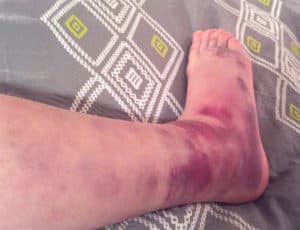
Once you are home, elevate the ankle, and make sure that you drink water and eat some food, preferably fruit. This will immediately raise your glucose levels and help keep you from going into shock. Have a blanket handy in case you get cold and start shivering. Absolutely try to get help from a friend, partner or family member to purchase a few needed items. Get a cane and a slip on ankle bandage that provides support and compression. Also an arnica based lotion to apply to help move the bruising through. My personal fav is Topricin.
Why a cane and not a crutch? A crutch will be much easier to move around on at first. However, it will create havoc on your shoulder. In addition, it will be too easy to get moving fast on it, which is a recipe for taking a quick wrong step and re-injuring the ankle. A cane is somewhat humbling, but you can't really move any faster on it than your bad ankle will let you, which is a good thing.
The first few days to weeks are not the time for massage for ankle sprains. Move it or lose it is the name of the game. Keep flushing it several times daily with rounds of circles and movement to a tolerable degree of discomfort. Too much and you'll probably just want to vomit. None, and the ankle will heal frozen in place and you'll just have to rip the tissue back open again to get it moving. Slow and steady wins the healing race.
Wear the compression brace whenever you plan to try walking on it. For now you'll need the stability and it will keep the blood pressure from feeling too awful. However, don't wear it 24/7. Take it off and elevate it at home when you can (and should) rest.
A simple brace that slips on like a sock is best. You can still move a bit in it and do recovery exercises and it fits better in shoes which are also going to give support. Here is a good brace.
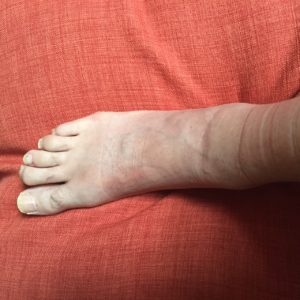
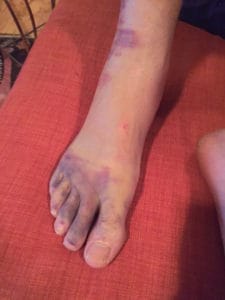
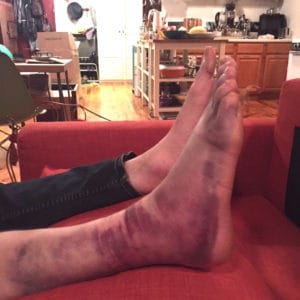
While it is possible to heal this type of injury on your own, you'll get far better and quicker results working with experienced wellness professionals. Work with an acupuncturist during the initial stages, and use massage therapy for ankle sprains, and a physical therapist as it starts to heal and take weight better.
DO NOT attempt to exercise on it until you can walk comfortably, without pain or discomfort, without wearing the brace. (At least not without direct guidance from a physical therapist.)
The main reason I'm already walking without a cane and almost no limp at 2 weeks is that I've gotten treated 3 times with e-stim by acupuncturist Erika Prinz . I've also had massage therapy sessions from my staff. E-stim (or Electroacupuncture) is especially valuable at the beginning stages to promote healing in the damaged tissue.
Now that I am walking mostly without a limp, and able to take stairs up and down reasonably well, my next move will be getting advanced massage therapy for ankle sprains from my staff in order to keep the injury from adversely affecting my knee and hip on the right leg. Often the biggest impediment to healing an injury all the way through is locked up compensating musculature in the rest of the body. In the beginning, this compensation was necessary to keep you from further injuring the ankle. Now, it's just in your way. A physical therapist colleague introduced me to using a wobble board for ankle sprain recovery and it's a life changer. Highly recommended!
Our tendency is to want to dive right back into our exercise routine once we feel like we have little to no pain. This is just asking for re-injury. Take 4-6 weeks to slowly but surely add back in exercise. Act like you've never worked out before. Start small and steady. My first "rehab" exercise was walking to a cafe down the block with my wife for brunch after being stuck at home for 4 days. If you used to run 6 miles a run 5 times a week, start with a walk to the subway. Then walk a quarter mile a few days later. Then walk a half mile in week 2. Maybe by week 3 you try running around the block once. Maybe.
If at any point you step weird and it feels hurt again (and trust me this will happen), take it easy, continue daily flushing. It's all part of the process of rebuilding a solid working structurally sound ankle.
If you bite off more than you can chew at this stage, you may step wrong, roll the ankle again, this time worse, tearing through already weak ligaments. Do you like the thought of having to take 8-12 MONTHS to recover?! Don't push too hard!
Would you like to schedule a massage in New York City? You can schedule massage for ankle sprains in the Financial District or Midtown West. Contact Bodyworks DW today or click on the button to book online at either of our studios!
This site uses Akismet to reduce spam. Learn how your comment data is processed.

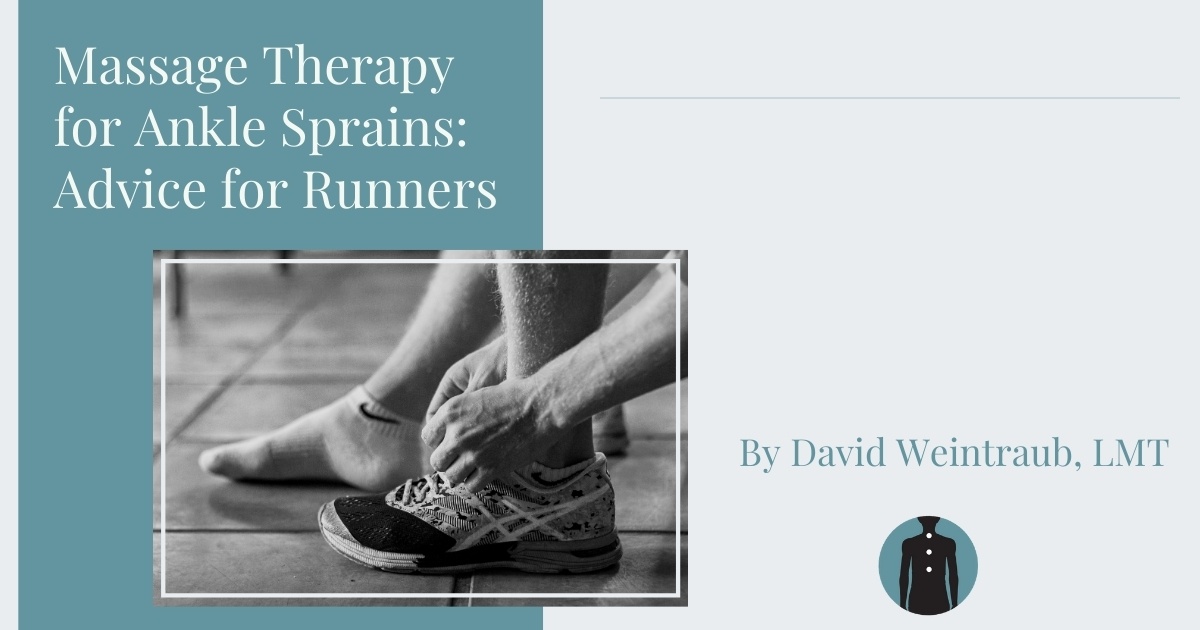
Pingback:
Thank you for this informative blog. One of my friend is an athlete and suffering from sprained ankle. Now he is looking for a good foot therapy from which he get faster results and get relief from it. I will share this wonderful blog with him so that he get benefit from this. And it will definitely help others too. Keep posting such blogs.
Thanks Isabella!
hello!! i just came by your article and i have a question about my ankle sprain that is similar to what you had. it’s been two weeks since my ankle sprain and my bruising has gone down gradually, my question is since i’ve never had an ankle sprain this bad before, how long did it take for the swelling around the ankle bone go away? i’ve been elevating my leg and wearing compression socks and also placing ice on my ankle bone but not as often as the first 3 days after my sprain. there’s only a slight swelling around my ankle bone. any advice is appreciated!!
Hi Kristy! Great question 🙂 Depending on how bad the injury is and other factors such as weight, fitness level, etc it can take weeks to months for the swelling to completely disappear. With a really bad sprain (like mine) I think the swelling didn’t totally go away until about 18-24 months. I’m not even entirely sure myself at what point I stopped thinking….that’s still looking swollen compared to the other ankle. Is it still in pain? – David
thank you for your fast reply!! wow two years I am hoping it will go back to normal in a month or so. no I am not in pain, I am able to walk normally with no limp, i believe i have a grade 2 sprain, the bruising you had is similar to mines but it wasn’t that bruised/discolored as compared to yours. I do go to the gym 3 times a week and I do use a workout machine that requires me to push off using my feet. I have been using ankle exercises and circular massages around my ankle bone to help reduce the swelling
Hi Kristy, you are doing all the right things and it should go back to normal within a few months at most. A big part of that swelling is not just dealing with tears in the muscles, but potentially in the tendons and ligaments themselves and that really does take a minimum of 2-3 months to fully heal. If you really want to accelerate the timeline you could try a set of compression boots like the ones Normantec and Therabody make. I have a pair of the Therabody Jet Boot Primes which are cost effective if you get into a good daily routine with them. (I wish they had these 9 years ago when I did my ankle…..). But you don’t “need” them, they’ll just speed up recovery.